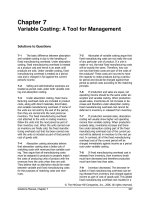Kendall7E ch07
Bạn đang xem bản rút gọn của tài liệu. Xem và tải ngay bản đầy đủ của tài liệu tại đây (1.52 MB, 44 trang )
Using Dataflow
Diagrams
Systems Analysis and Design,
7e
Kendall & Kendall
© 2008 Pearson Prentice Hall
7
Learning Objectives
• Comprehend the importance of using logical and
•
•
•
•
physical data flow diagrams (DFDs) to
graphically depict movement for humans and
systems in an organization
Create, use, and explode logical DFDs to
capture and analyze the current system through
parent and child levels
Develop and explode logical DFDs that illustrate
the proposed system
Produce physical DFDs based on logical DFDs
you have developed
Understand and apply the concept of
partitioning of physical DFDs
Kendall & Kendall
7-2
Data Flow Diagrams
• Graphically characterize data
processes and flows in a business
system
• Depict:
• System inputs
• Processes
• outputs
Kendall & Kendall
7-3
Major Topics
• Data flow diagram symbols
• Data flow diagram levels
• Creating data flow diagrams
• Physical and logical data flow
diagrams
• Partitioning
• Communicating Using Data Flow
Diagrams
Kendall & Kendall
7-4
Advantages of the Data
Flow Approach
• Freedom from committing to the
technical implementation too early
• Understanding of the
interrelatedness of systems and
subsystems
• Communicating current system
knowledge to users
• Analysis of the proposed system
Kendall & Kendall
7-5
Basic Symbols
• A double square for an external
entity
• An arrow for movement of data from
one point to another
• A rectangle with rounded corners for
the occurrence of a transforming
process
• An open-ended rectangle for a data
store
Kendall & Kendall
7-6
Figure 7.1 The four basic symbols used in
data flow diagrams, their meanings, and
examples
Kendall & Kendall
7-7
External Entities
• Represent another department, a
business, a person, or a machine
• A source or destination of data,
outside the boundaries of the
system
• Should be named with a noun
Kendall & Kendall
7-8
Data Flow
• Shows movement of data from one
point to another
• Described with a noun
• Arrowhead indicates the flow
direction
• Represents data about a person,
place, or thing
Kendall & Kendall
7-9
Process
• Denotes a change in or transformation
of data
• Represents work being performed in the
system
• Naming convention
• Assign the name of the whole system when
naming a high-level process
• To name a major subsystem attach the
word subsystem to the name
• Use the form verb-adjective-noun for
detailed processes
Kendall & Kendall
7-10
Data Store
• A depository for data that allows
examination, addition, and retrieval of
data
• Named with a noun, describing the data
• Data stores are usually given a unique
reference number, such as D1, D2, D3
• Represents a:
• Filing cabinet
• Database
• Computerized file
Kendall & Kendall
7-11
Figure 7.2 Steps in
developing data flow
diagrams
Kendall & Kendall
7-12
Creating the Context
Diagram
• The highest level in a data flow
diagram
• Contains only one process,
representing the entire system
• The process is given the number 0
• All external entities, as well as
Major data flows are shown
Kendall & Kendall
7-13
Figure 7.3 Context
diagram
Kendall & Kendall
7-14
Drawing Diagram 0
• The explosion of the context
diagram
• May include up to nine processes
• Each process is numbered
• Major data stores and all external
entities are included
Kendall & Kendall
7-15
Drawing Diagram 0
(Continued)
• Start with the data flow from an
entity on the input side
• Work backwards from an output
data flow
• Examine the data flow to or from a
data store
• Analyze a well-defined process
• Take note of any fuzzy areas
Kendall & Kendall
7-16
Figure 7.3 Note the greater
detail in diagram 0
Kendall & Kendall
7-17
Data Flow Diagram Levels
• Data flow diagrams are built in layers
• The top level is the Context level
• Each process may explode to a lower
level
• The lower level diagram number is the
same as the parent process number
• Processes that do not create a child
diagram are called primitive
Kendall & Kendall
7-18
Creating Child Diagrams
• Each process on diagram 0 may be
exploded to create a child diagram
• A child diagram cannot produce
output or receive input that the
parent process does not also
produce or receive
• The child process is given the same
number as the parent process
• Process 3 would explode to Diagram 3
Kendall & Kendall
7-19
Creating Child Diagrams
(Continued)
• Entities are usually not shown on
the child diagrams below Diagram 0
• If the parent process has data flow
connecting to a data store, the child
diagram may include the data store
as well
• When a process is not exploded, it
is called a primitive process
Kendall & Kendall
7-20









